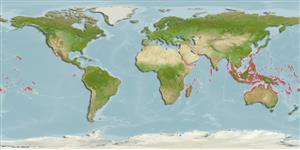>
Carangiformes (Jacks) >
Carangidae (Jacks and pompanos) > Trachinotinae
Etymology: Trachinotus: Greek, trachys, -eia, -ys = rough + Greek,noton = back (Ref. 45335).
More on author: Lacepède.
Environment: milieu / climate zone / depth range / distribution range
Ökologie
seewasser; brackwasser riff-verbunden; tiefenbereich 0 - 3 m (Ref. 89972). Tropical; 32°N - 32°S
Indo-Pacific: Red Sea to the Line and Mangaréva islands, north to southern Japan, south to Lord Howe and Rapa.
Size / Gewicht / Alter
Maturity: Lm ? range ? - ? cm
Max length : 60.0 cm TL Männchen/unbestimmt; (Ref. 4225); common length : 35.0 cm TL Männchen/unbestimmt; (Ref. 5450); max. veröff. Gewicht: 1.5 kg (Ref. 30874)
Rückenflossenstacheln (insgesamt): 7; Rückenflossenweichstrahlen (insgesamt): 20-24; Afterflossenstacheln 3; Afterflossenweichstrahlen: 20 - 24.
Adults occur near surface waters of lagoon and seaward reefs, in surge zones along sandy beaches (Ref. 48635, 90102). They always move in schools at the edge of the surf near the reef, usually in pairs or small groups in surface waters (Ref. 48635). They feed on small fishes (Ref. 9710). They are occasionally taken by trolling and line fishing.
Life cycle and mating behavior
Geschlechtsreife | Fortpflanzung | Ablaichen | Eier | Fecundity | Larven
Paxton, J.R., D.F. Hoese, G.R. Allen and J.E. Hanley, 1989. Pisces. Petromyzontidae to Carangidae. Zoological Catalogue of Australia, Vol. 7. Australian Government Publishing Service, Canberra, 665 p. (Ref. 7300)
IUCN Rote Liste Status (Ref. 130435)
Bedrohung für Menschen
Harmless
Nutzung durch Menschen
Fischereien: weniger kommerziell; Sportfisch: ja
Mehr Information
NamenSynonymeMetabolismusRäuberÖkotoxikologieFortpflanzungGeschlechtsreifeAblaichenSpawning aggregationFecundityEierEientwicklung
ReferenzenAquakulturAquakultur ProfilZuchtlinienGenetikElectrophoresesVererbbarkeitKrankheitenVerarbeitungNutrientsMass conversion
Tools
Zusatzinformationen
Download XML
Internet Quellen
Estimates based on models
Preferred temperature (Ref.
123201): 24.7 - 29.3, mean 28.4 °C (based on 3280 cells).
Phylogenetic diversity index (Ref.
82804): PD
50 = 0.5000 [Uniqueness, from 0.5 = low to 2.0 = high].
Bayesian length-weight: a=0.01259 (0.00582 - 0.02724), b=2.96 (2.77 - 3.15), in cm total length, based on LWR estimates for this (Sub)family-body shape (Ref.
93245).
Trophic level (Ref.
69278): 3.6 ±0.52 se; based on food items.
Widerstandsfähigkeit (Ref.
120179): mittel, Verdopplung der Population dauert 1,4 - 4,4 Jahre. (Preliminary K or Fecundity.).
Fishing Vulnerability (Ref.
59153): Moderate vulnerability (44 of 100).
Nutrients (Ref.
124155): Calcium = 59.6 [27.7, 127.3] mg/100g; Iron = 0.837 [0.442, 1.569] mg/100g; Protein = 19.9 [17.9, 21.9] %; Omega3 = 0.113 [0.065, 0.209] g/100g; Selenium = 18.4 [9.9, 37.0] μg/100g; VitaminA = 80.1 [22.5, 267.8] μg/100g; Zinc = 1.2 [0.8, 1.7] mg/100g (wet weight);
